Where Every Scroll is a New Adventure
Composition - Blog Posts
“If evil were not made to appear attractive, there would be no such thing as temptation.”
-Billy Graham
The Creator's Poem
I am your poem,
Created in Christ Jesus
To imitate Him
I'm Your masterpiece,
Crafted from the beginning
For the Prince of Peace
Creator's poem
Named human, for Your glory
Your will, Your poem

Day 18, relation
In this artwork I can see classic composition
Or is there another reason why I feel like I’ve already seen it?

Panorama, 2021
I usually don’t carry such artworks, but here is a contexture that feels so canon and right, I couldn’t pass.
Actually it is assembled from three different parts, you may see the seams.

Sketchbook 1, a friend told me that my sketchbook is cool, not all instagram post need to be finished drawings, just be yourself . . . . #sketchbook #calarts #calartssketchbook #doodles #ink #anatomydrawing #gouache #paint #composition #visualdevelopment #gobelins https://www.instagram.com/p/BusU_M5l5nZ/?utm_source=ig_tumblr_share&igshid=wfj64b0n26iz

A dream . . . . #environmentdesign #conceptart #visualdevelopment #visdev #backgrounddesign #artistoninsta #colorpalette #digitalpainting #illustration #composition #marseille https://www.instagram.com/p/BtrflOrlzoy/?utm_source=ig_tumblr_share&igshid=14s3his22p39n

I decided to do a #masterstudy of #jcleyendecker with my dear Warrie, took me a ton of time even that, it was worth it, I want to get better next year at digital painting bc I love how it is used in the visdev indistry, honestly, making a more realistic style was inspired my Hamletmachine and Onoboro artstyles, they are awesome artist too . . . . #chelsychaconocwarrenreddington #illustration #artistoninstagram #painting #visdev #visualdevelopment #characterdesign #storytelling #cartoon #retropainting #flowers #realism #art #illustrator #animation #colorpalette #childrenillustration #humanpainting #humanfigure #anatomy #color #humanpose #oilpainting #composition #humanbody #arttutorial #photoshop https://www.instagram.com/p/BrmCKG6h9Fk/?utm_source=ig_tumblr_share&igshid=1ur94v94gt98g

Random color experimentation
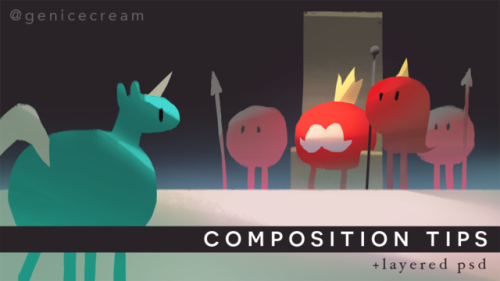
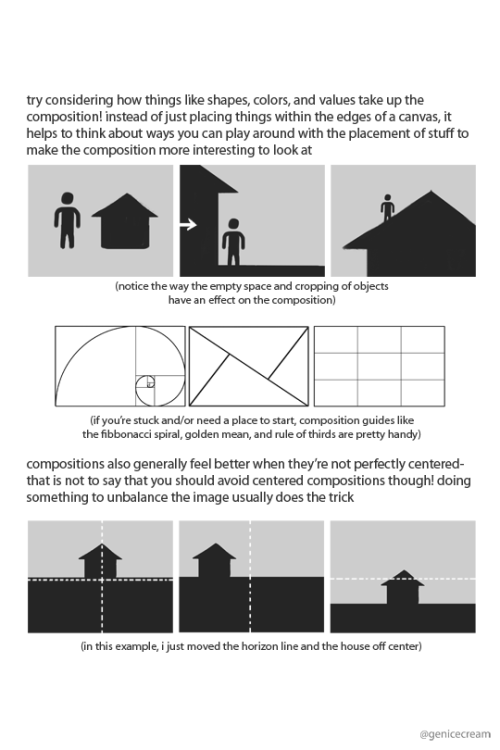
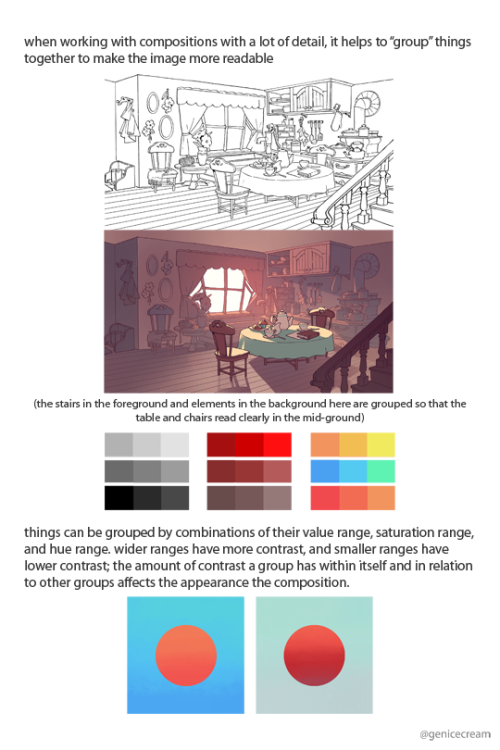
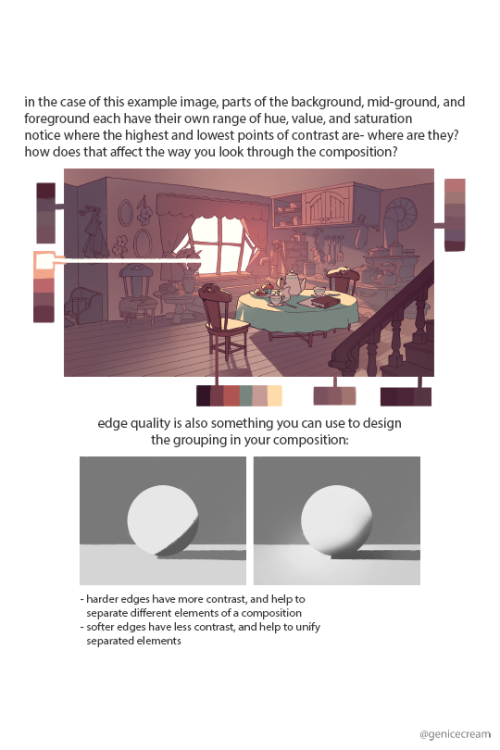
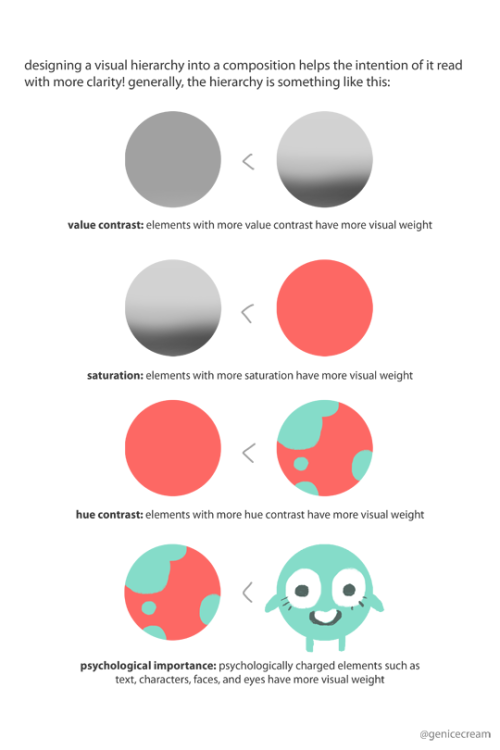
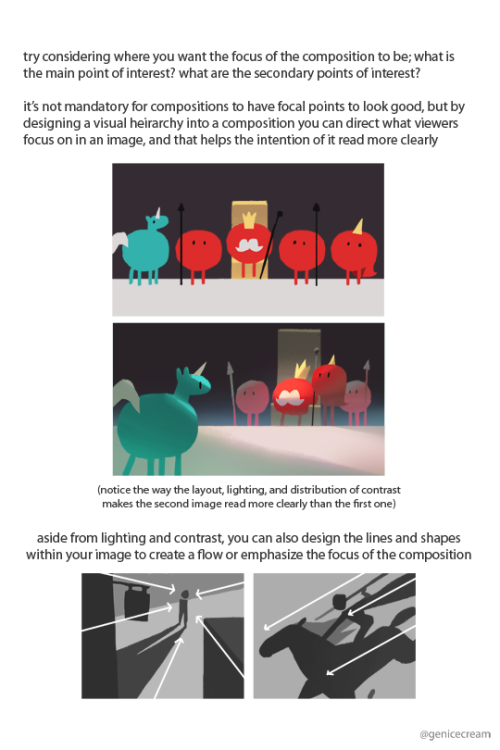

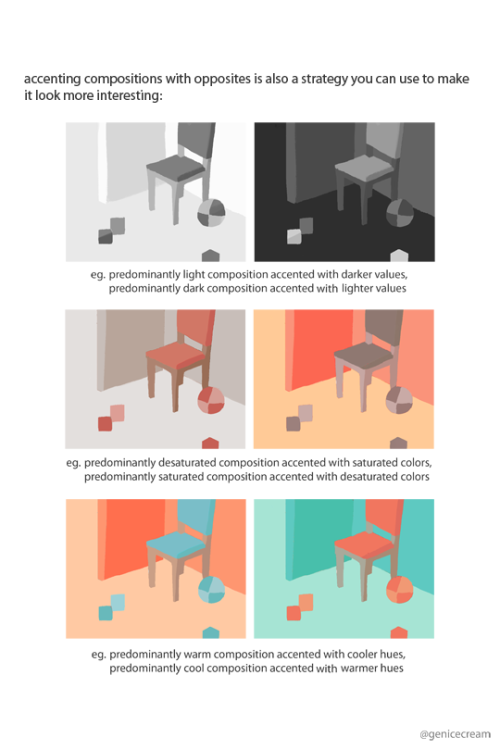
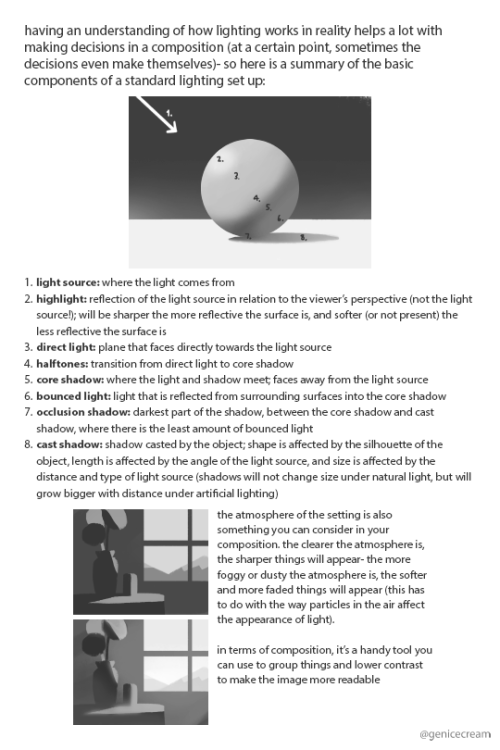
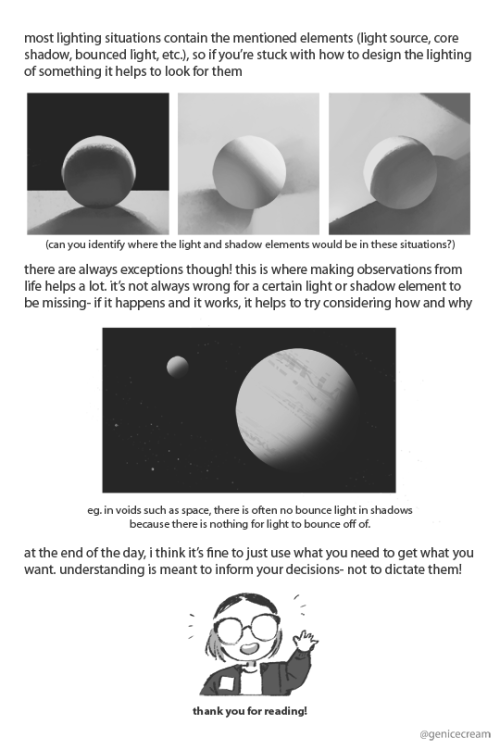
a series of composition tips i’d been sharing on twitter!
and since some people had asked, i’ve put up a pdf version of this on gumroad along with a layered psd of one of the example images too
tips would be really appreciated, but it’s up for free!
Some original songs I wrote
This isn't all of them nor are they new but I felt terrible for not posting them to tumblr lol
Comment or reblog which one(s) you liked the most!

Untitled, Washington State - 2017

Sink and Mirror, Guangxi China
Photography
Elements of Design
Line
Definition: The path of a moving point is a mark made by a tool or instrument as it is drawn across a surface.
Types: Vertical, Horizontal, Curved, ZigZag, Diagonal
Notable Example: "The Eiffel Tower" by Henri Cartier-Bresson - showcasing elegant vertical lines.
Shape
Definition: The area stands out from the shape next to or around it because of a defined boundary or because of value, color, or texture.
Notable Example: "Migrant Mother" by Dorothea Lange - illustrating the emotional impact of the human shape within its surroundings.
Color
Definition: A visual sensation caused by light.
Notable Example: "Afghan Girl" by Steve McCurry - using vibrant color to convey the subject's striking gaze.
Components: Hue, Value, Intensity
Hue refers to the pure, basic colors of the color wheel. It is what distinguishes one color from another, such as red, blue, or yellow.
Example: In a rainbow, each band of color represents a different hue.
Value represents the lightness or darkness of a color. It is determined by the amount of light reflected by a color. A range of values creates contrast and depth in an image.
Example: In a grayscale image, the variations from black to white represent different values of gray.
Intensity, also known as saturation, refers to the purity or vividness of a color. A highly saturated color is pure and vibrant, while a desaturated color is more muted or grayish.
Example: A highly saturated red will be bright and vibrant, while a desaturated red will appear more subdued.
Space
Definition: The area occupied by form. The main area is positive, everything else is negative.
Notable Example: "Moonrise, Hernandez, New Mexico" by Ansel Adams - masterfully using negative space to emphasize the moonrise.
Value
Definition: How light or dark a given color or hue can be.
Notable Example: "The Old Guitarist" by Pablo Picasso (photographed by André Villers) - utilizing value to evoke emotion in a monochromatic context.
Form
Definition: Where light and shape collide to create images with depth and a sense of touchability.
Notable Example: "Nude Descending a Staircase, No. 2" by Marcel Duchamp (photographed by Man Ray) - playing with form and movement in a surreal way.
Texture
Definition: The visual depiction of variations in the color, shape, and depth of an object's surface.
Notable Example: "Migrant Mother" by Dorothea Lange - highlighting the weathered texture of the subject's face and hands.
Practice:
Take 5 photos demonstrating lines or explore more variations.
Principles
Balance
Definition: Feeling of equality in weight.
Types: Symmetrical, Asymmetrical, Radial
Notable Example: "The Birth of Venus" by Sandro Botticelli - showcasing symmetrical balance in a classic painting.
Proportion
Definition: Deals with the ratio of one part to another. Ratio implies comparison and is expressed in size, number, position, and space.
Notable Example: "Vitruvian Man" by Leonardo da Vinci - exploring the proportions of the human body in a meticulous drawing.
Harmony
Definition: Creates unity by stressing the similarities of separate but related parts.
Notable Example: "Starry Night" by Vincent van Gogh - achieving harmony through the use of color and swirling patterns.
Variety
Definition: A change or contrast within one or more elements to add interest and to avoid monotony.
Notable Example: "Les Demoiselles d'Avignon" by Pablo Picasso - introducing variety through diverse and unconventional forms.
Movement
Definition: Where your eyes look in a picture.
Notable Example: "Dance at Le Moulin de la Galette" by Pierre-Auguste Renoir - capturing the lively movement of dancers in a joyful scene.
Unity
Definition: The whole or total effect of a work of art that results from the combination of all its components.
Notable Example: "Guernica" by Pablo Picasso - achieving unity in a powerful anti-war painting.
Rhythm
Definition: A continuance, a flow, or a feeling of movement achieved by the repetition of related visual units; the use of measured accents.
Notable Example: "The Dance" by Henri Matisse - creating a sense of rhythm through repeated, flowing shapes.
Emphasis
Definition: The stressing of an element to make it more interesting or important through one position, color, object, or texture.
Notable Example: "Girl with a Pearl Earring" by Johannes Vermeer - emphasizing the subject's enigmatic gaze and the play of light on the pearl.
Composition
The way the principles of art are used to organize the elements of art. It determines the movement or direction it takes your eyes around the picture. There are many types of compositions; some of them resemble an S, O, U, T, L, S, and more. Understanding composition enhances the overall impact and storytelling in your photographs.
Composition in photography refers to the arrangement and organization of visual elements within a frame to create a compelling and harmonious image. It involves making deliberate choices about how to position and combine various elements like lines, shapes, colors, and textures. A well-composed photograph not only captures the subject but also guides the viewer's eyes in a way that enhances the overall impact and storytelling of the image.
Key Aspects of Composition:
Framing:
Choosing what to include within the frame and what to leave out is crucial. The frame acts as a boundary, focusing attention on the subject.
Rule of Thirds:
Dividing the frame into a 3x3 grid and placing key elements along these lines or at their intersections can create a visually pleasing balance.
Leading Lines:
Lines within an image (like a road, river, or architectural elements) can guide the viewer's eyes toward a focal point or create a sense of movement.
Symmetry and Asymmetry:
Symmetry can create a sense of balance, while asymmetry adds visual interest. Both can be used to guide the viewer's focus.
Contrast:
Contrast in color, tone, or texture helps certain elements stand out, drawing the viewer's eyes to specific areas of the photograph.
Depth and Perspective:
Creating a sense of depth enhances the three-dimensional feel of a photograph. This can be achieved through techniques like using leading lines, overlapping elements, or varying focus.
Balance:
Achieving balance ensures that no single element dominates the composition. Balance can be symmetrical, asymmetrical, or radial, depending on the desired effect.
Guiding the Viewer's Eyes:
Visual Hierarchy:
Establish a hierarchy of importance within the image. This can be achieved through the use of size, color, or contrast to make certain elements more prominent.
Focal Point:
Clearly define a focal point to which the viewer's eyes are naturally drawn. This can be the main subject or a strategically placed element within the composition.
Leading Lines:
Utilize leading lines to guide the viewer's eyes toward the main subject or a specific area of interest within the frame.
Contrast and Color:
Use contrast and color to create emphasis. A pop of color or a high-contrast element can immediately attract attention.
Positioning and Flow:
Consider how the viewer's eyes will move across the image. Arrange elements to create a natural flow that leads the eyes from one point of interest to another.
In summary, composition is about purposefully arranging elements within the frame to create a visually pleasing and impactful image. By understanding the principles of composition, photographers can effectively guide the viewer's eyes, control the narrative, and evoke specific emotions or reactions.
Practice:
Here are three famous photographs where you can circle or draw an arrow to the focal point:
"Migrant Mother" by Dorothea Lange:
Assignment: Circle to highlight the focal point. Consider how the photographer uses the expressions and gaze to create a compelling focal point.
"Afghan Girl" by Steve McCurry:
Assignment: Circle or draw an arrow pointing to the focal point. Notice how the intense gaze creates a powerful focal point and draws the viewer into the subject's emotions.
"The Falling Soldier" by Robert Capa:
Assignment: Draw an arrow pointing to the focal point. Reflect on how this focal point captures a decisive moment in the chaos of war, conveying both action and vulnerability.
For each photograph, consider the composition techniques that contribute to the effectiveness of the focal point. Pay attention to factors like framing, contrast, and the placement of elements within the frame. This exercise can help enhance your understanding of how photographers use focal points to guide and engage the viewer.

This article was written by Phil Straub back in 2005, and it is as fresh and vital today as it was then. Phil’s tips and trick are timeless, and can help you make your images pop!
Composition is everything! No amount of detail in an illustration or Concept Painting will be successful without a strong composition foundation.
Composition in Environment Concept painting can be quite difficult since your focal point usually isn’t as obvious as in a character piece. In this introduction to Composition we will explore the fundamentals used to create exciting and functional compositions along with a variety of composition techniques. Initially I will show some successful examples of iconic composition, formal composition, the rule of 3rds, the golden rule, etc. There will be a discussion on what makes each piece successful and an explanation on why the artist chose to describe the scene using a particular form of composition.


When you take the canvas area and divide it into ‘thirds’ Horizontally and Vertically, where the lines cross in the picture area is a ‘Golden Mean’, or the best spot in which to place your Main Subject or Object of Interest as it is the Focal Point of your picture. The golden rule originates from the Ancient Greeks, since they were great mathematicians as well as artisans, they came to the conclusion that there needed to be a certain balance in composition for it to be pleasing to the eye. They further developed this theory and defined what they called “power points,” Power points are located at the point where the lines used in the golden rule intersect. By placing a main subject on a power point, it further defined that subject as the focal point.
The golden rule can and usually is applied to a paintings canvas proportions. As you read through the following text you’ll notice that most of the imagery presented utilizes similar dimensions and almost all of them fall into the “golden rectangle.” Today you can find the Golden Rectangle almost everywhere: from credit cards to phone cards to book covers, all are shaped with its proportions. The Golden Ratio (the ratio of the longer and shorter sides of the Golden Rectangle) also appears in many natural phenomena. The ratio between the length of your nose and the distance from the bottom of the chin to the bottom of the nose is the golden ratio. The spiral growth of crustaceans follows the golden spiral. The divine proportions are an in-built (or in-grained) aesthetic parameter we judge beauty by.
The imagery [above] represents the division of space when the “golden rule” is applied to a blank canvas. Basically it is the division of a line in two sections, where the ratio between the smallest section and the largest section is identical to the ratio between the largest section and the entire length of the line. In other words A/B = B/(A+B). The ratio is about 1/1.618. Honestly, I’m still not exactly sure what that all means? but, I do know that I used this grid layout a-lot when I first started painting and found it helpful. I still do.
In the beginning you may find it useful to use this as an overlay for every concept piece you do. Having this grid float over your imagery as a reminder of where to place the objects of importance in the scene may help you as your develop your composition.

From the golden rule came the “rule of thirds” which is virtually the same concept but slightly altered to fit photographic proportions.I find it a bit easier to follow since it’s very simple in its origin.Here we have a look at the rule of thirds in action.
Notice that the main focal point sits right almost directly over one of the “golden means.” Additionally, other objects are placed near the other converging lines (the bird, for example) but, not directly on them, since that would create competition for the focal point.
There are Four Spots where these lines cross the Upper Left the Lower Left, the Upper Right and the Lower Right. Please note that all the “hotspots” are away from the center position in the picture frame.
The two best “power points” are the Upper Right and the Lower Right because the eye enters the picture frame at the lower left hand corner of the picture frame, travels to the center of the picture area and then reaches the right hand ‘Golden Mean’ position where it stops to look at the ‘Center Of Interest’.
The reason the eye enters a picture at the lower left side is because we are taught to read from Left to Right. This is a psychological fact that has been proven over the years. Next time you’re in an art gallery or art museum that shows the Old Masters paintings, notice how many have the Center Of Interest in the “Golden Rule” positions.


‘Implied Forms’ are a combination of ‘Implied Lines’ and they help to hold a painting together. The eye enjoys these interesting forms and will stay in the picture area to examine each one of them, if they are present. The following text and sample imagery will demonstrate a variety of implied forms and composition approaches.

The Circle is made up of a continuous ‘Curve’ and it’s circular movement keeps the eye in the picture frame. There are many circles in nature and man made objects. You can use the circle in a very obvious way in your composition or simply suggest it.
The image [below] is a very obvious and deliberate usage of circular composition. Notice how the circular shapes created by the dragons also follow a path that leads your eye towards the focal point.

Another example of circular composition! Again, I chose this type of composition to enhance the feeling of motion in the piece. You can see how the eye follows the circular shapes across the picture plane to the focal point. Something interesting to note with this image, it actually uses two composition approaches at one time; circular composition and iconic composition.


This has a ‘solid base’ and will show Stability. It also has Height and Strength. The Pyramids of Egypt have survived for thousands of years while other types of solid buildings have crumbled in to dust in less time. With the image below I was very deliberate with my arrangement of shapes so the triangle or pyramid composition is obvious. When I began this piece I simply started with a triangle shape as my starting point…nothing more than an abstract composition. I just let everything flow from there….and very quickly the painting began to take shape.


Is a connection of ‘Lines’ meeting in the Center and an expansion of ‘Lines’ leaving the Center. The Radii is usually found in Nature Subjects. The best example of the man made Radii is the spokes of a wheel.
The eye has two ways to go when it comes upon the Radii. It can either be drawn in to the picture area or it can be led out of the picture area. You must be careful how you used the Radii and try to have the eye led into the picture.


A showing of ‘Opposing Force’ that will give the picture a feeling of Cohesion and Relationship. The horizontal bar of the Cross will act as a “stopper’ while the vertical pole can act as a leading line. The windows in a large skyscraper will form crosses and will keep your interest in the building. The Cross also has religious meaning and the subtle use of the Cross can give hidden significance to an image.
In the painting below Hong Kuang uses the cross composition subtly. One could argue this piece is also using an “L Composition.” The strong line across the horizontal center that’s being formed by the characters body suggests “The Cross.” The somber facial expression and subject matter demonstrate an experienced artist’s ability to use symbolic composition to help tell a narrative.
To the right of that is Daryl Mandryk’s work which successfully combines a Cross composition with iconic composition. This is common composition choice for themes of heroism or comics. Fantasy artists like Brom and Frazetta use this type of composition in their work regularly.


This makes an attractive ‘frame’. It can be used to accentuate important subjects. Many times it is a ‘frame’ within a ‘frame’.
A tree with an overhanging branch at the ‘right’ side of the picture area will form a ‘Rectangle’ and help frame the Main Subject in the picture. By doing this you will make the Center of Interest stand out and be noticed clearly.


Some Art theorists contend that the most important information in the image should be placed near the center of the picture plane. This may seem confusing to some students since this contradicts many of the major principles of the “golden rule.” In general iconic composition should and can be used to describe a subject in a certain way. Iconic Composition or “Formal Subdivision” applies best to subjects of a dignified or religious nature. This style of composition was the approach of choice in earlier times and many excellent compositions have been made with it. Usually Iconic composition is used to describe symbolic subjects, heroic subjects, or religious subjects.

I’ve taken the liberty of drawing over this imagery to demonstrate the division of space in iconic composition. This is a technique used by many illustrators to help define the division of space and focal point when creating an iconic illustration. Well know and renowned illustrator Andrew Loomis used this technique extremely well and his book “Creative Illustration” to demonstrate this further.
Notice, that while the focal point is slightly off center, all the converging lines lead to the center point of interest. Additionally, notice how the figures head sits directly in the diamond shape of the overlay lines I’ve created. It should also be noted that I chose this composition to further enhance the regal and heroic appearance of the character.

Tong Wu uses Iconic composition perfectly here! Notice how the character again falls nearly at center of the canvas. I’ve taken the division of space a bit further on this imagery and have broken down the image into smaller segments so you can so how the artist balances everything in the piece.
Notice how the top right corner is almost a mirror image of the top left corner. In fact, look at almost any opposing segment in the painting, they are very similar! When creating iconic composition, it’s not necessary to duplicate each side exactly, but there should be a feeling of complete equalization of the units or masses, the line and spaces of one side with the other.

So, there you have it, a variety of ways to deal with division of space when you first begin visualizing a painting or drawing. At the end of the day, theses approaches to composition are guides and simply a place to start. Once you become more comfortable with composing a scene you can begin to push the boundaries of formal composition.
Since most Environment Concept Artists work in the entertainment industries, its expected you will be asked to create cinematic moments or “memorable moments” utilizing the environment as a stage.
You’ll want to use your mastery of composition to lead the viewer’s eye and really make the viewer feel like they’re in the scene. The single most important thing you simply must have in any Environment Concept Painting is a clear and dynamic focal point.
Without a place for the viewer’s eye to rest, the painting will lack impact and won’t hold the attention of your audience. It’s the job of the Concept Artist to visualize what can’t be visualized in reality. Concept Artists are the first step in every production and therefore must create dynamic imagery that the rest of the team will be excited to build. There are a few cinematic tricks that you can use as a Concept Artist to make things appear more dynamic.

Sometimes all it takes to add an extra bit of drama to your composition is a simple tilt of the camera. In the image to the right the viewer really feels like they are part of the action, simply by slanting the camera a bit. This approach is especially useful when you are trying to depict action in your environment.


Many Concept Artists today, myself included, use perspective as a tool to create dynamic compositions that appear to have motion and lead the eye to the focal point clearly and concisely.
In the painting below you will notice I’ve used many of the objects that appear in the painting as opportunities to further guide the viewer to the “payoff.” Additionally, I tilted the camera a bit to add to the action.

http://www.cgsociety.org/index.php/CGSFeatures/CGSFeatureSpecial/phil_straub_composition_tutorial

Columbia Pictures Intro | Spider-man: Into The Spider-Verse (2018)










End credits of Spider-Man: Into The Spider-Verse

Jean Dubuffet - Cristallisation du rêve - 1952

















